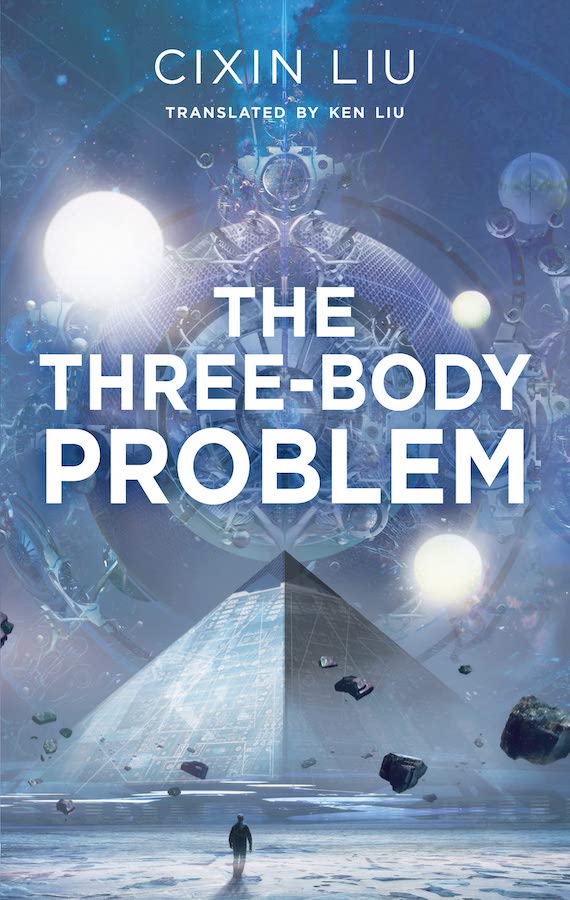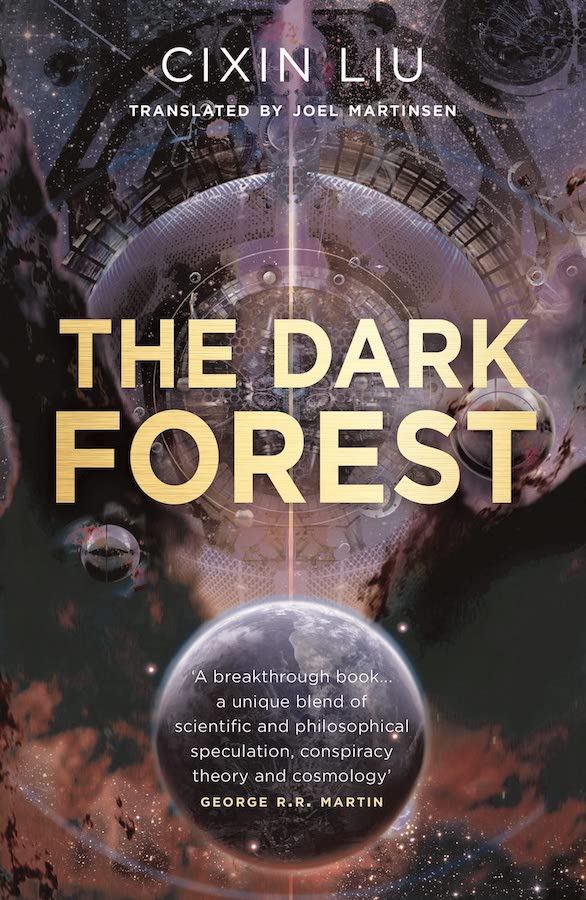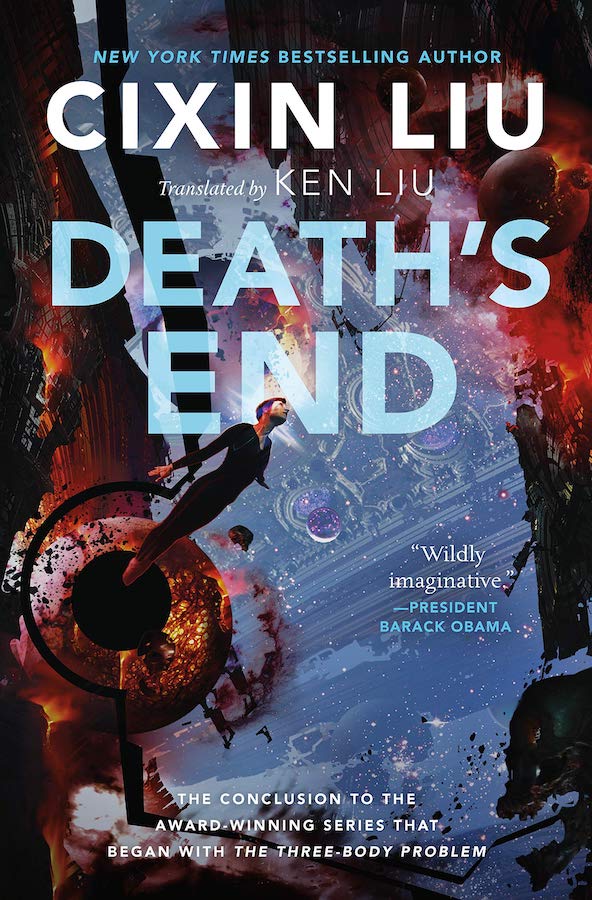


I don’t usually read science fiction novels, but after reading rave reviews I decided to pick up a copy of Cixin Liu's The Three-Body Problem. It is indeed a marvelous novel and after finishing the first volume I also ordered the second and third volume of the trilogy, The Dark Forest and Death’s End, which I found even better.
The trilogy as a whole is actually titled Remembrance of Earth’s Past, but it is often referred to as The Three-Body Problem series. The three volumes were originally published in China in 2006, 2008 and 2010. The Three-Body Problem spans multiple decades and by the end of the third volume we’re several million years into the future. By that time we’ve also crossed into higher dimensions. Cixin Liu pulls it all off with ease.
The first half or so of The Three-Body Problem is set against the backdrop of the Chinese Cultural Revolution and I must say that I found some sections a bit hard-going. But let’s not forget that The Three-Body Problem is a Chinese novel that was written for a Chinese readership, not for a global audience.
Ye Wenjie is an astrophysics student who witnesses how her father is beaten to death by Red Guards. She herself is sent to a labour camp. After being betrayed by a journalist whom she had befriended she is sent to prison. There she is recruited by the Chinese military to work at a secret site, whose true purpose is the search for extraterrestrial life, or so Ye Wenjie discovers at some point. She develops a way to send messages further into the universe than was hitherto possible by using the sun as an amplifier. Some eight years later Ye receives a message from a planet called Trisolaris, which urges her not to respond or else she will disclose her location in the universe. Without telling anyone about her discovery, Ye, disillusioned by her marriage and humanity at large, responds anyway and invites the aliens to come to Earth.
Some years later Ye, now a university professor, meets with Mike Evans, a wealthy radical environmentalist who believes that Earth would be better off without humans. Ye confides in Evans and tells him about the message she received some years earlier. Evans uses his wealth to construct an observatory station and upon receiving a message from Trisolaris he sets out to establish a secret society, the Earth-Trisolaris Organization (ETO), with Ye Wenjie as its leader, to welcome the aliens. Eventually and unsurprisingly ETO splits into three rival factions, each with their own agenda and attitude towards the Trisolarans.
The Three-Body Problem, the first volume of the trilogy, takes its title from a problem in classical mechanics which consists of the problem of determining the motion of three celestial bodies moving under no influence other than that of their mutual gravitation. This matters because the aliens that Ye Wenjie inadvertently makes contact with come from a planet that has three suns, which is why it is referred to as Trisolaris. As a consequence its climate is erratic. Brief stable eras unexpectedly give way to chaotic eras with extreme droughts during which days can last years. Its inhabitants have evolved the capacity to dehydrate to survive periods of drought and extreme heat. When the Trisolarans learn that planet Earth has just one sun they decide to migrate, never mind that Earth is already occupied. Fortunately for humanity Trisolaris is four light years away, and given the speed with which Trisolarans travel this gives us four hundred years to prepare for their arrival.
There is an important metaphor in here. For the extreme weather events, from hurricanes to heat and drought, that are both intensifying and becoming more frequent, can be seen as an indication that Earth’s climate is entering a chaotic phase.
The story of Ye Wenjie is interspersed with that of Wang Miao, a nanotechnologist enlisted by the police to help solve a series of mysterious murders of several prominent scientists. Wang discovers that they were all members of a secret society who played a virtual reality game called Three Body, which is set on a planet whose climate randomly switches from stable to chaotic eras. Wang infiltrates the society and solves the game when he realizes that the planet is orbited by three suns, which causes the climate to behave as it does.
Wang tells the police what he has learned during the secret society’s meetings and Ye Wenjie is arrested. Documents found by the police reveal that a large invasion fleet is on its way and will reach Earth in approximately 400 years. The documents also reveal that the Trisolarans possess highly advanced technology, which includes subatomic AI devices called sophons, some of which have already been sent to Earth and keep a check on further advances in fundamental physics by disrupting the operation of particle accelerators. This is where the first volume ends.
The second volume, The Dark Forest, introduces a number of new plot lines and characters, one of whom will also become a central character in the third volume of the trilogy, Death’s End. In both the second and the third volume the story also gains pace as Cixin Liu introduces ever more fantastic elements.
I really liked to concept of the Wallfacers. To coordinate Earth’s defense against the attack of the Trisolarans the UN has established a Planetary Defense Council. This council in turn has appointed four “Wallfacers” who are granted unprecedented rights and resources to develop a defense strategy, which they are to keep secret, because the sophons cannot read minds. This of course leads Trisolaris and its human allies of ETO to appoint three “Wallbreakers”.
One of the wallfacers is Luo Ji, a Chinese “cosmic sociologist” and a former student of Ye Wenjie, who is appointed because, for unknown reasons, he is perceived as a threat by the Trisolarans, who have put him on a hit list. Luo Ji is a proponent of the Dark Forest theory of the universe, which basically states that, because one doesn't know in advance whether an alien civilization is a friend or a foe, it is best to keep one's own location in the universe secret and if technology allows it, to strike first and ask questions later. By threatening to reveal the location of Trisolaris, which might lead to its destruction by an even more technologically advanced civilization, Luo Ji is able to ward off Earth’s imminent destruction. As a proof of concept Luo has the location of a distant star broadcast to the entire universe, which years later is indeed destroyed by an unknown high-speed object. But of course Luo Ji's tenure doesn't last forever.
The Dark Forest hypothesis and the stable era that lasts for the duration of Luo Ji's tenure as wallfacer, can again be read as a metaphor for our current predicament. It is only during periods in which there are no geopolitical risks that one can benefit from economic prosperity and have the luxury to indulge in pacifism.
I also liked the idea, first introduced in The Dark Forest, that characters can go into hibernation to be awakened again several years or centuries into the future. This allows Cixin Liu to jump through time and have characters re-appear later in the story.
Death’s End, the third book in the trilogy, is my favourite novel in the series, because it demands the greatest stretch of the imagination. Perhaps rather surprisingly the first chapter is set in 15th century Constantinople. It then switches to the time when Ye Wenjie first made contact with Trisolaris, before moving on to the time of The Dark Forest and beyond. Cixin Liu has neatly named the different times at which the story is set the Common Era, the Crisis Era, the Deterrence Era, the Broadcast Era, the Bunker Era and the Galaxy Era. As we move from the Broadcast Era to the Bunker Era and finally the Galaxy Era, Cixin Liu takes ever greater flights of fancy eventually taking us to other galaxies and micro-universes. On this journey the reader is accompanied by a couple of characters, which guarantee the storyline’s continuity.
The Three-Body Problem trilogy is heavy on scientific concepts and Cixin Liu has gone to great lengths to create a fictional universe that is at least internally consistent. Apart from physics and mathematics there is also a fair amount of game theory, especially in the storyline of the Wallfacers and the Swordholder.
Ultimately The Three-Body Problem trilogy is an inspiring and optimistic novel as Cixin Liu imagines all kinds of technological breakthroughs on the horizon. As such The Three-Body Problem is also an invitation to dream. Wouldn’t it be great to travel to a far corner of the universe at near light-speed or to enter a slowly fading four-dimensional fragment of space?